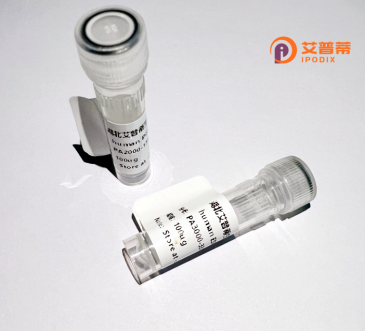
| 纯度 | >90%SDS-PAGE. |
| 种属 | Human |
| 靶点 | CDC2L5 |
| Uniprot No | Q14004 |
| 内毒素 | < 0.01EU/μg |
| 表达宿主 | E.coli |
| 表达区间 | 1-324aa |
| 氨基酸序列 | MLPEDKEADSLRGNISVKAVKKEVEKKLRCLLADLPLPPELPGGDDLSKSPEEKKTATQLHSKRRPKICGPRYGETKEKDIDWGKRCVDKFDIIGIIGEGTYGQVYKARDKDTGEMVALKKVRLDNEKEGFPITAIREIKILRQLTHQSIINMKEIVTDKEDALDFKKDKGAFYLVFEYMDHDLMGLLESGLVHFNENHIKSFMRQLMEGLDYCHKKNFLHRDIKCSNILLNNRGQIKLADFGLARLYSSEESRPYTNKVITLWYRPPELLLGEERYTPAIDVWSCGCILGELFTKKPIFQANQELAQLELIRHEENEVSDKQI |
| 分子量 | 61.38 kDa |
| 蛋白标签 | GST-tag at N-terminal |
| 缓冲液 | 0 |
| 稳定性 & 储存条件 | Lyophilized protein should be stored at ≤ -20°C, stable for one year after receipt. Reconstituted protein solution can be stored at 2-8°C for 2-7 days. Aliquots of reconstituted samples are stable at ≤ -20°C for 3 months. |
| 复溶 | Always centrifuge tubes before opening.Do not mix by vortex or pipetting. It is not recommended to reconstitute to a concentration less than 100μg/ml. Dissolve the lyophilized protein in distilled water. Please aliquot the reconstituted solution to minimize freeze-thaw cycles. |
以下是关于重组人CDC2L5(CDK13)蛋白的3篇参考文献及其摘要概述:
1. **标题**:*The role of CDK13 in RNA transcription and splicing*
**作者**:Greifenberg, A.K., et al.
**摘要**:该研究通过重组表达人CDK13蛋白,结合体外激酶实验和RNA测序,揭示了CDK13在调控RNA聚合酶II转录延伸及前体mRNA剪接中的关键作用,证明其激酶活性对维持剪接体功能至关重要。
2. **标题**:*Characterization of recombinant human CDC2L5 kinase domain and its interaction with cyclins*
**作者**:Chen, H.H., et al.
**摘要**:作者通过大肠杆菌系统重组表达并纯化CDC2L5激酶结构域,分析其与细胞周期蛋白(Cyclin K)的相互作用,揭示其依赖Cyclin K的激酶活性及其在细胞周期调控中的潜在功能。
3. **标题**:*CDK13 mutations disrupt recognition of transcriptional RNA components in cancer*
**作者**:Koh, S.M., et al.
**摘要**:该研究在癌症样本中鉴定了CDK13突变体,利用重组蛋白进行体外功能验证,发现突变导致其RNA结合能力及激酶活性丧失,提示CDK13异常可能通过转录失调驱动肿瘤发生。
**备注**:CDC2L5(即CDK13)相关研究相对较少,部分文献可能涉及同家族蛋白(如CDK12)。建议通过PubMed或Web of Science以“CDK13 recombinant”或“CDC2L5 kinase”为关键词检索更新进展。
Recombinant human CDC2L5 protein, also known as cyclin-dependent kinase 13 (CDK13), is a member of the cyclin-dependent kinase (CDK) family involved in transcriptional regulation and cell cycle control. CDK13 plays critical roles in RNA processing, including the phosphorylation of RNA polymerase II’s C-terminal domain (CTD) to regulate transcription elongation and mRNA splicing. It interacts with cyclin K to form a functional kinase complex, influencing gene expression programs linked to cell proliferation, differentiation, and apoptosis. Structurally, CDK13 contains conserved kinase domains and a unique arginine/serine-rich (RS) domain, which mediates interactions with splicing factors. Dysregulation of CDK13 has been implicated in cancers and developmental disorders, making it a target for therapeutic research. Recombinant CDK13 is typically produced using expression systems like *E. coli* or mammalian cells, followed by purification to study its enzymatic activity, substrate specificity, and inhibitor screening. Its recombinant form enables biochemical and structural studies to dissect molecular mechanisms and explore drug discovery avenues. Research on CDK13 also sheds light on its non-canonical roles in DNA damage response and chromatin remodeling, highlighting its versatility in cellular processes.
×